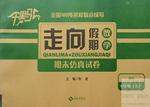
阅读理解
阅读下列短文,从每题所给的四个选项中选出最佳选项。
More than 3 million years ago, our ancestors were already on the march, rising on two legs to search for food, seek greener lands and, above all, to grow in body and brain. Let's meet some of them:
1.Australopithecus afarensis
They had apelike faces and their brains were a third the size of modern humans' brains. They lived 3~3.9 million years ago. Fossils (化石) were found in Ethiopia (埃塞俄比亚) in 1974.
2.Paranthropus boisei
Covered with fur, they had strong arms and gorillalike faces. They lived 1~2.5 million years ago. Fossils were found in Tanzunia (坦桑尼亚) in 1959.
3.Homo habilis
Homo habilis, which actually means“handy man”, was the first species to make and use primitive stone tools. They lived 1.6~2.2 million years ago. Fossils were found in Tanzania in 1960.
4.Homo erectus
With skeletons very similar to those of modern humans, they were probably the first to use fire. They lived 30,000~1.8 million years ago. Fossils have been found in Africa and Asia since 1893.
5.Homo heidelbergensis
They were skilled hunters who used spears to kill animals. Their bodies were similar to ours, although more muscular and larger boned. They lived 200,000~500,000 years ago. Fossils have been found in Ethiopia, Germany, France and Spain since 1921.
6.Homo Neanderthal
Their brains were at least as large as the average modern humans', while their smaller bodies helped them deal with cold climates. They lived 30,000~230,000 years ago. Fossils have been found in France and Iraq since 1856.
1.What is considered more important in the development of the human?
[ ]
A.Man could stand on two feet.
B.Man's brain became big enough.
C.Man's arms became strong.
D.Man could use the stone tools.
2.Handy man's fossils were found in _____.
[ ]
A.Tanzania in 1960
B.Germany in 1921
C.France in 1856
D.Tanzania in 1959
3.Which of the following lived earliest on the earth?
[ ]
A.Homo Neanderthal.
B.Homo habilis.
C.Paranthropus boisei.
D.Australopithecus afarensis.
 千里马走向假期期末仿真试卷寒假系列答案
千里马走向假期期末仿真试卷寒假系列答案科目:高中英语 来源: 题型:阅读理解
阅读下面这首乐府诗,完成下列各题。
菩萨蛮
王安石【注】
数间茅屋闲临水,窄衫短帽垂杨里。花是去年红,吹开一夜风。
梢梢新月偃,午醉醒来晚。何物最关情,黄鹂三两声。
【注】:此词为王安石晚年罢相后回到金陵卜居于半山时所作。
词的开篇就点出“闲”字,请结合全词,谈谈作者是怎样表现“闲”字的?
素洁平易而又含蓄深沉是这首词的基本特色,请你就“含蓄深沉”这一特色谈谈对这首词的理解。
查看答案和解析>>
科目:高中英语 来源: 题型:阅读理解
第三部分 阅读理解(共15小题;每小题2分,满分30分)
请认真阅读下列短文,从短文后各题所给的A、B、C、D四个选项中,选出最佳选项,并在答题卡上将该项涂黑。
A
Scars of Love
Some years ago on a hot summer day in south Florida a little boy decided to go for a swim in the old swimming hole behind his house. In a hurry to dive into the cool water, he ran out of the back door, leaving behind shoes, socks and shirt as he went.
He flew into the water, not realizing that as he swam toward the middle of the lake, an alligator(短吻鳄) was getting close. The mother in the house was looking out of the window and saw the two as they got closer and closer together. In great fear, she ran toward the water, yelling to her son as loudly as she could. Hearing her voice, the little boy became alarmed and made a U-turn to swim to his mother. It was too late. Just as he reached her, the alligator reached him. From the dock, the mother grabbed her little boy by the arms just as the alligator snatched (抓住) his legs. That began an unbelievable tug-of-war (拔河比赛) between the two. The alligator was much stronger than the mother, but the mother was much too passionate to let go. A farmer happened to drive by, heard their screams, rushed from his truck, took aim and shot the alligator.
Remarkably, after weeks and weeks in the hospital, the little boy survived. His legs were extremely scarred (留下伤疤) by the terrible attack of the animal. And on his arms, were deep scratches where his mother’s fingernails dug into his flesh in her effort to hang on to the son she loved.
The newspaper reporter, who interviewed the boy after the trauma (外伤), asked if he would show him his scars. The boy lifted the pant legs. And then, with obvious pride, he said to the reporter, “Look at my arms. I have great scars on my arms, too. I have them because my mum wouldn’t let go.”
You and I can identify with (认同) that little boy. We have scars, too. Not from an alligator, but the scars of a painful past. Some of those scars are unsightly and have caused us deep regret. But, some wounds, my friends, are because we have refused to let go.
56. The underlined part “the two” in the second paragraph refers to ______.
A. the alligator and the mother B. the mother and the son
C. the driver and the alligator D. the son and the alligator
57. From the passage we can infer ________.
A. The mother was unwilling to let the alligator go
B. The mother was actually stronger than the alligator
C. The son was proud of his scars on his arms
D. The son was ashamed of his scars on his legs
58. According to the last paragraph, what is the writer’s real meaning?
A. To forget the past is to betray. B. We should forget the scars.
C. Wounds are different from scars. D. We should learn to let go sometimes.
查看答案和解析>>
湖北省互联网违法和不良信息举报平台 | 网上有害信息举报专区 | 电信诈骗举报专区 | 涉历史虚无主义有害信息举报专区 | 涉企侵权举报专区
违法和不良信息举报电话:027-86699610 举报邮箱:58377363@163.com